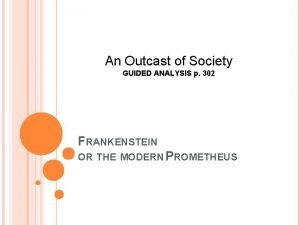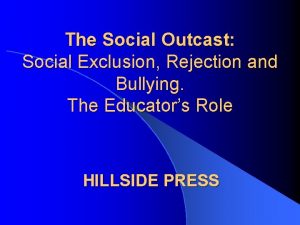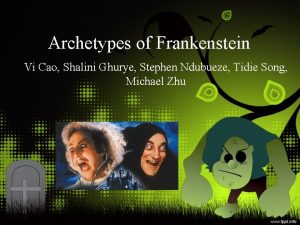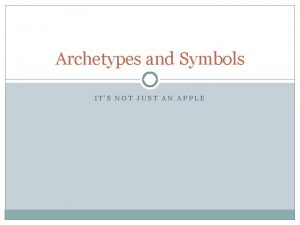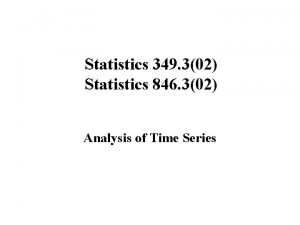An Outcast of Society GUIDED ANALYSIS p 302





- Slides: 5

An Outcast of Society GUIDED ANALYSIS p. 302 FRANKENSTEIN OR THE MODERN PROMETHEUS

1. Look at the title of the passage you are about to read. Do you know the meaning of the word “outcast? If you don’t. Look it up in your monolingual dictionary and write down the definition. • Outcast: a person who has no place in their society or in a particular group because the society or group refuses to accept them. (Cambridge Dictionary) 2. Then read the passage and say whether you find the title appropriate. • The title is appropriate. The monster is an outcast of society because he has been rejected by men. 1. Read up to line 16 a. Who is speaking? • The monster (first-person narrator) b. To whom? • He is speaking to Dr Frankenstein, his creator.

2. Read the passage through. a. Is the child’s reaction at the view of the monster consistent with the monster’s hopes? Why? / Why not? • No, the monster had hoped that the innocence of the child wouldn’t make him feel the horror and disgust that adults felt at the sight of his deformity. b. How does the monster react to the horror expressed by the child on seeing him? • The child’s reaction triggers the monster’s rage. c. What words express the child’s horror? • • “Let me go. . . papa” (ll. 22 -24); Hideous monster. . . Dare not keep me. ” (ll. 26 -27). d. What is the real reason that causes the monster’s rage” and his killing of the child? • The discovery that the child is Dr Frankenstein’s little brother.

2. Read the passage through. e. How does the monster react to the murder? • He feels powerful because he can cause despair in Dr Frankenstein who created him in such a dreadful way and made him an outcast of society. 3. Personal response Do you consider the monster a malignant being or the victim of his creator and /or society? • The monster is a victim both of his creator– who himself admits he has given life to a loathsome being – and of society, which is prejudiced against deformity. 4. Complete the summary with an appropriate word in each blank. • The monster hides in the fields; there he sees a _______ and in his desperate need for _______ and affection, is suddenly struck by the ______ that if he seized the ______ and kept him as his ______ educating him to be his ______ , life might be bearable. The child’s ______ at seeing him and the ______ that the boy is Frankenstein’s ______, however, , enrage the monster beyond control. In a fit of ______ he takes his ______ on the child for his sense of frustration at being ______ by men, and kills him. The outcast of _____ has, despite himself, become a ______ in more than a physical sense.

4. Complete the summary with an appropriate word in each blank. • The monster hides in the fields; there he sees a boy and in his desperate need for company and affection, is suddenly struck by the idea that if he seized the child and kept him as his companion educating him to be his friend, life might be bearable. The child’s reaction at seeing him and the discovery that the boy is Frankenstein’s son, however, enrage the monster beyond control. In a fit of rage he takes his revenge on the child for his sense of frustration at being rejected by men, and kills him. The outcast of society has, despite himself, become a monster in more than a physical sense. 5. In “Frankenstein” Mary Shelley introduces such themes as the relationship between science and ethics, on the one hand, and the isolation of the individual neglected by society, on the other. Think back on the two passages analysed and say how these themes are treated (maximum 150 words). The themes of the relationship between science and ethics and the isolation of the individual are clearly dealt with in the two excerpts from “Frankenstein” we have just analysed. In particular theme of the effects of science on man is examined in the passage “The Creation of the monster” where Mary Shelley describes Dr Frankenstein’s attempt at creating a human being through scientific experiments. This episode can be seen as a sort of warning against the risks humanity runs whenever the scientist tries to overcome the limits imposed on man by nature. The theme of the isolation of the individual is instead well depicted in the passage “An Outcast of Society”. The monster is so desperately looking for human friendship that he conceives the idea of kidnapping a child in order to make him his companion. The little child's reaction of disgust at the sight of the monster's deformity once again frustrates the monster's hopes making him a monster not only physically but also in a moral sense: the monster in fact becomes a mass murderer with the little child being as his first victim. (188 words).
